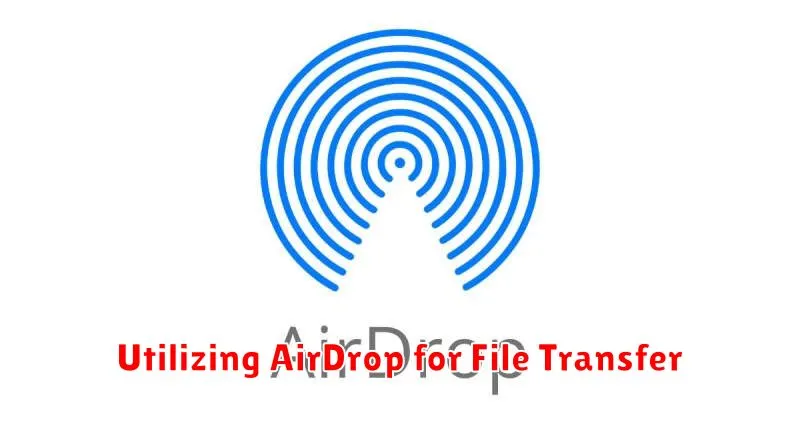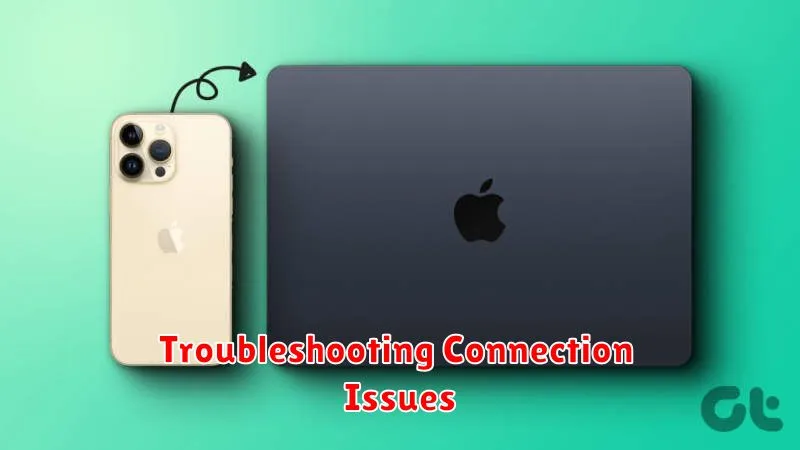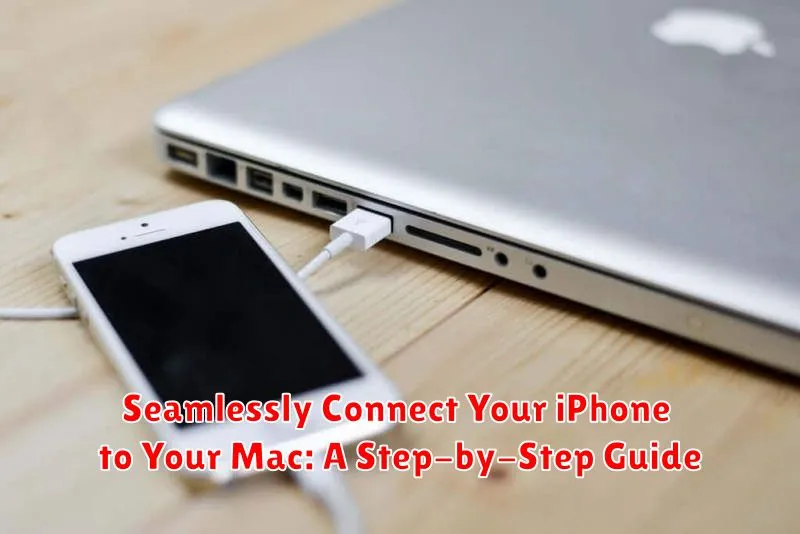Connecting your iPhone to your Mac can significantly enhance your workflow and unlock a world of seamless integration between your devices. Whether you need to transfer files, back up your iPhone data, access photos and videos on a larger screen, or utilize powerful Mac applications with your iPhone, a strong connection is essential. This step-by-step guide will provide you with the knowledge and instructions necessary to establish a robust and reliable connection, regardless of your technical expertise. We’ll cover various methods, including using a USB cable, establishing a Wi-Fi connection, and leveraging the power of Bluetooth. Master the art of connecting your iPhone to your Mac and unlock a new level of productivity and convenience.
In this comprehensive guide, we will delve into the intricacies of connecting your iPhone to your Mac, exploring several connection methods to cater to different needs and preferences. From the simplicity of a USB connection for rapid file transfers and charging, to the wireless freedom of Wi-Fi and Bluetooth for accessing shared resources and features, you will learn the optimal approach for your specific use case. We will also address common troubleshooting tips and tricks to ensure a smooth and uninterrupted experience. By the end of this guide, you will be equipped with the expertise to confidently connect your iPhone to your Mac and harness the full potential of both devices.
Preparing Your iPhone and Mac for Connection
Before establishing a connection, ensure both your iPhone and Mac meet the minimum system requirements. Check your iPhone’s iOS version and your Mac’s macOS version. Ensure both devices are updated to the latest software for optimal compatibility and performance. This is crucial for accessing all available features and ensuring a stable connection.
Enable Wi-Fi and Bluetooth on both your iPhone and Mac. While not all connection methods require both, having them enabled simplifies the process and allows for a smoother transition between different connectivity options.
Sign in to the same Apple ID on both devices. This is essential for features like iCloud syncing, AirDrop, and Handoff to function correctly. Using the same Apple ID ensures data and services are seamlessly shared between your devices.
Ensure your iPhone has sufficient battery life, or connect it to a power source. Certain operations, particularly data transfer and backup, can consume significant power. A stable power supply prevents interruptions during these processes.
Have your iPhone’s passcode readily available. You may be prompted to enter it on your iPhone during the initial pairing process for security verification. This confirms that you authorize the connection between the two devices.
Establishing a Wired Connection
A wired connection offers a reliable and fast method for connecting your iPhone to your Mac. This is particularly useful for transferring large files or when a stable connection is paramount.
You will need a Lightning to USB cable. Connect the Lightning end of the cable to your iPhone’s charging port. The other end, the USB connector, should be plugged into a USB port on your Mac.
Upon connection, your iPhone may prompt you to “Trust This Computer.” Tap “Trust” if you intend to regularly connect your iPhone to this Mac. This step authorizes data transfer and certain management features.
Your iPhone should now appear in the Finder sidebar on your Mac. Clicking on your iPhone in the Finder provides access to various management options and allows for direct file transfer between devices.
Connecting Wirelessly via Bluetooth
Bluetooth offers a convenient wireless method to connect your iPhone and Mac, primarily for sharing peripherals and using features like Handoff and Continuity. While Bluetooth doesn’t facilitate file transfers in the same way as AirDrop or a wired connection, it enables a seamless experience for certain functionalities.
To establish a Bluetooth connection, ensure Bluetooth is enabled on both your iPhone and Mac. On your iPhone, go to Settings > Bluetooth and toggle it on. On your Mac, click the Bluetooth icon in the menu bar and select “Turn Bluetooth On.” Your Mac will then automatically search for nearby devices.
When your iPhone appears in the list of available devices on your Mac, select it. You may be prompted to enter a code displayed on both devices to confirm the pairing. Once paired, your devices will remain connected until manually disconnected or moved out of range.
Key Bluetooth features you can utilize include Handoff, allowing you to start a task on one device and seamlessly continue on the other, and Continuity features like Universal Clipboard, which lets you copy and paste text and images between your iPhone and Mac. You can also use your iPhone’s Personal Hotspot feature to share its cellular data connection with your Mac via Bluetooth, although using Wi-Fi for this purpose offers better performance.
Utilizing AirDrop for File Transfer

AirDrop provides a quick and easy method for transferring files between your iPhone and Mac wirelessly. Ensure both devices have Wi-Fi and Bluetooth enabled.
On your iPhone:
- Open the file you wish to share.
- Tap the Share icon.
- Select your Mac from the list of available AirDrop devices.
On your Mac:
- A notification will appear showing the incoming file.
- Click Accept to save the file to your Downloads folder, or choose a different location.
Important Considerations:
- Ensure both devices are within a reasonable range of each other (typically up to 30 feet).
- Check your AirDrop receiving settings on your Mac (Contacts Only or Everyone) in Finder under AirDrop.
Syncing Data with iCloud
iCloud provides a seamless method for keeping your iPhone and Mac synchronized. This ensures your essential data, including photos, contacts, calendars, and notes, are consistently up-to-date across both devices.
Enabling iCloud Sync: On your iPhone, navigate to Settings > [Your Name] > iCloud. Toggle on the switches for the data types you wish to sync. Ensure you are signed in with the same Apple ID on both your iPhone and Mac.
Managing iCloud Storage: Your free iCloud account comes with limited storage. If you require more space for backups and data, consider upgrading to an iCloud+ plan through the storage management options in your device settings.
Understanding iCloud Backup: iCloud automatically backs up your iPhone daily when it’s connected to power and Wi-Fi. This backup includes device settings, app data, and more. You can also initiate a manual backup through the iCloud settings.
Troubleshooting Connection Issues

Occasionally, you might encounter problems connecting your iPhone and Mac. This section provides troubleshooting steps for common issues.
Basic Troubleshooting
First, ensure both devices are charged and updated to the latest software versions. A simple restart of both your iPhone and Mac can often resolve minor glitches. Check that your cables are undamaged and correctly plugged into both devices.
Connectivity Checks
For wired connections, try a different USB port or cable. If using Bluetooth, verify that it’s enabled on both devices and they are within range. Ensure that Wi-Fi is enabled for features that rely on it, such as AirDrop and iCloud sync.
Software Conflicts
If the issue persists, consider potential software conflicts. Check for recently installed apps or updates on either device that might be interfering with connectivity.
Managing Your iPhone from Your Mac
Your Mac offers several tools to manage your iPhone efficiently. Finder is a central hub for various management tasks.
Connect your iPhone to your Mac and open Finder. Your iPhone will appear in the Finder sidebar under Locations. From here, you can create and restore backups, update iOS, and manage stored files like photos, videos, and music. You can also organize apps and update them directly from your Mac.
Music, Podcasts, and TV apps allow synchronization and management of respective media content between your Mac and iPhone. These apps enable seamless content transfer and offline playback management on your device.
Advanced Connectivity Options
Beyond the standard connection methods, several advanced options enhance the iPhone-Mac synergy. Instant Hotspot allows your Mac to connect to your iPhone’s cellular data seamlessly, eliminating the need for separate Wi-Fi networks. This is especially useful when working remotely or in areas with limited internet access.
Continuity features extend the functionality between devices. Handoff enables you to start a task on one device and seamlessly continue on another. For example, begin writing an email on your iPhone and finish it on your Mac. Universal Clipboard allows copying text, images, or other content on one device and pasting it onto the other.
Sidecar transforms your iPad into a secondary display for your Mac, expanding your workspace. While not directly involving the iPhone, this feature adds to the ecosystem’s interconnectedness, offering greater flexibility when working with your Apple devices.

